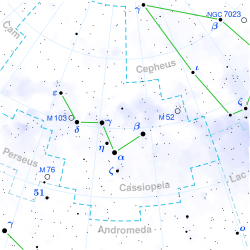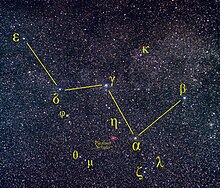 ζ Cassiopeiae is found just south of the W asterism | |
| Observation data Epoch J2000 Equinox J2000 | |
|---|---|
| Constellation | Cassiopeia |
| Right ascension | 00 36 58.28419 |
| Declination | +53° 53′ 48.8673″ |
| Apparent magnitude (V) | 3.66 (3.59 - 3.68) |
| Characteristics | |
| Spectral type | B2IV |
| U−B color index | –0.89 |
| B−V color index | –0.19 |
| Variable type | SPB |
| Astrometry | |
| Radial velocity (Rv) | 2.0 km/s |
| Proper motion (μ) | RA: 17.38 mas/yr Dec.: –9.86 mas/yr |
| Parallax (π) | 5.50 ± 0.16 mas |
| Distance | 590 ± 20 ly (182 ± 5 pc) |
| Absolute magnitude (MV) | –2.8 |
| Details | |
| Mass | 8.3 M☉ |
| Radius | 5.9 R☉ |
| Luminosity | 5,500 L☉ |
| Surface gravity (log g) | 3.81 cgs |
| Temperature | 20,426 K |
| Metallicity | –0.23 dex |
| Rotation | 5.37045 |
| Rotational velocity (v sin i) | 17 ± 3 km/s |
| Other designations | |
| Fulu, Zet Cas, ζ Cas, 17 Cassiopeiae, BD+53°105, FK5 17, GC 727, HD 3360, HIP 2920, HR 153, SAO 21566 | |
| Database references | |
| SIMBAD | data |
Zeta Cassiopeiae, Latinized from ζ Cassiopeiae, and officially named Fulu /ˈfuːluː/, is a variable star in the constellation of Cassiopeia. It has a blue-white hue and is classified as a B-type subgiant with an apparent magnitude of +3.66. Based upon parallax measurements, it is approximately 590 light-years from the Sun.
Nomenclature
ζ Cassiopeiae (Latinised to Zeta Cassiopeiae) is the star's Bayer designation.
In Chinese astronomy, Zeta Cassiopeiae is called 附路, Pinyin: Fùlù, meaning Auxiliary Road, because this star is marking itself and standing alone in the Auxiliary Road asterism, Legs (mansion) (see Chinese constellation). 附路 (Fùlù) was westernized into Foo Loo, but that name was also designated for Eta Cassiopeiae by R.H. Allen, with the meaning of "a by-path" In 2016, the IAU organized a Working Group on Star Names (WGSN) to catalog and standardize proper names for stars. The WGSN approved the name Fulu for Zeta Cassiopeiae on 30 June 2017 and it is now so included in the List of IAU-approved Star Names.
Properties

Zeta Cassiopeiae is a B2 subgiant, indicating that it has exhausted its core hydrogen and started to evolve away from the main sequence. It has a temperature of over 20,000 K, is about eight times the mass of the sun, and is 5,500 times as luminous.
Variability

Zeta Cassiopeiae is a probable member of an unusual group of variable stars known as "Slowly Pulsating B" (SPB) stars. It shows a pulsation frequency of 0.64 per day (or once every 1.56 days) and displays a weak magnetic field with a strength of roughly 3.35 × 10 T, which varies with a period of 5.37 days. This likely matches the rotation rate of the star, which, when combined with the low projected rotational velocity, indicates the star may be seen nearly pole-on. Zeta Cassiopeiae is a candidate magnetic Bp star that shows an overabundance of helium. The star contains a randomly oriented fossil magnetic field, which impacts the outflow of the stellar wind. Collisions between streams from this stellar wind creates a shock front, with cooling particles settling toward a co-rotating disk.
References
- ^ van Leeuwen, F. (November 2007), "Validation of the new Hipparcos reduction", Astronomy and Astrophysics, 474 (2): 653–664, arXiv:0708.1752, Bibcode:2007A&A...474..653V, doi:10.1051/0004-6361:20078357, S2CID 18759600
- Ducati, J. R. (2002). "VizieR Online Data Catalog: Catalogue of Stellar Photometry in Johnson's 11-color system". CDS/ADC Collection of Electronic Catalogues. 2237: 0. Bibcode:2002yCat.2237....0D.
- ^ Neiner, C.; Geers, V. C.; Henrichs, H. F.; Floquet, M.; Frémat, Y.; Hubert, A.-M.; Preuss, O.; Wiersema, K. (2003). "Discovery of a magnetic field in the Slowly Pulsating B star zeta Cassiopeiae" (PDF). Astronomy and Astrophysics. 406 (3): 1019. Bibcode:2003A&A...406.1019N. doi:10.1051/0004-6361:20030742.
- Morgan, W. W.; Keenan, P. C. (1973), "Spectral Classification", Annual Review of Astronomy and Astrophysics, 11: 29, Bibcode:1973ARA&A..11...29M, doi:10.1146/annurev.aa.11.090173.000333
- ^ Johnson, H. L.; et al. (1966), "UBVRIJKL photometry of the bright stars", Communications of the Lunar and Planetary Laboratory, 4 (99): 99, Bibcode:1966CoLPL...4...99J
- Jaschek, C.; Gomez, A. E. (1998). "The absolute magnitude of the early type MK standards from HIPPARCOS parallaxes". Astronomy and Astrophysics. 330: 619. Bibcode:1998A&A...330..619J.
- Gies, Douglas R.; Lambert, David L. (March 1992), "Carbon, nitrogen, and oxygen abundances in early B-type stars", Astrophysical Journal, Part 1, 387: 673–700, Bibcode:1992ApJ...387..673G, doi:10.1086/171116
- ^ "Zeta Cas -- Pulsating variable Star", SIMBAD, Centre de Données astronomiques de Strasbourg, retrieved 2010-02-22
- ^ "Naming Stars". IAU.org. Retrieved 16 December 2017.
- (in Chinese) AEEA (Activities of Exhibition and Education in Astronomy) 天文教育資訊網 2006 年 7 月 9 日 Archived 2011-05-22 at the Wayback Machine
- Richard Hinckley Allen: Star Names — Their Lore and Meaning: Cassiopeia
- "IAU Working Group on Star Names (WGSN)". Retrieved 22 May 2016.
- "MAST: Barbara A. Mikulski Archive for Space Telescopes". Space Telescope Science Institute. Retrieved 24 December 2024.
- Neiner, C.; et al. (2003), "Discovery of a magnetic field in the Slowly Pulsating B star zeta Cassiopeiae", Astronomy and Astrophysics, 406 (3): 1019–1031, Bibcode:2003A&A...406.1019N, doi:10.1051/0004-6361:20030742
- De Cat, P. (June 2007), "Observational Asteroseismology of slowly pulsating B stars", Communications in Asteroseismology, 150: 167–174, Bibcode:2007CoAst.150..167D, doi:10.1553/cia150s167
- Smith, M. A.; Bohlender, D. A. (May 2007), "Variations of the ultraviolet resonance lines of the B2 IV-V star ζ Cassiopeiae", Astronomy and Astrophysics, 466 (2): 675–682, arXiv:astro-ph/0702461, Bibcode:2007A&A...466..675S, doi:10.1051/0004-6361:20066639, S2CID 59063221
| Constellation of Cassiopeia | |||||||||||||
|---|---|---|---|---|---|---|---|---|---|---|---|---|---|
| Stars |
| ||||||||||||
| |||||||||||||
| |||||||||||||
| Nebulae |
| ||||||||||||
| Galaxies |
| ||||||||||||
| |||||||||||||